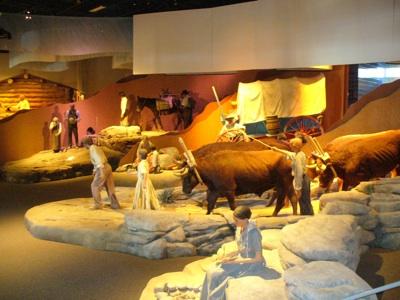Editor's note: As David and Kay Scott continue westward on their 2010 National Park Road Trip, they're finding wide open stretches of the West as they follow the route of the Oregon National Historic Trail. Along the way, they're finding many worthwhile stopping places.
Greetings from the town of Rock Springs, in the southwestern corner of Wyoming. Another night in a motel as the wind was blowing hard and we were unable to locate two U.S. Bureau of Land Monument campgrounds in the high country northeast of here. Plus, the weather forecast was spotty and we were both tired.
We are beginning our fifth week on the road and have driven approximately 3,300 miles through 13 states since leaving home in Valdosta, Georgia. Being accustomed to high humidity, the dry air here is causing our nails to crack, our skin to flake, and our noses to clog. It normally takes at least a couple of weeks for us to adjust to the low humidity. The wind seems to never cease. On a positive note, temperatures in the 90s are tolerable. Today the temperature is expected to get into the 70s.
Our last note was from Casper, Wyoming. We spent several hours in the National Historic Trails Interpretive Center, on the north end of town. What a great place for two people attempting to follow the Oregon Trail. The facility, operated by the Bureau of Land Management, offers interactive exhibit galleries and a 17-minute multimedia program about westward migration. One exhibit allows visitors to step inside a covered wagon and ford a river. Although the crossing is accomplished by means of a video shown in the front of the wagon, the effect is pretty neat. A similar stagecoach exhibit is also in the center. Admission is $6 for adults, but there is no charge for holders of American the Beautiful passes.
After buying groceries and gasoline in Casper, we set off southwest across central Wyoming. This is a unpopulated, wild, and beautiful section of the state. The initial 40 to 50 miles are void of water and vegetation, making it a rough section of the trip west for pioneers who crossed the North Platte River at Casper. The wide vistas in central Wyoming offer a number of important landmarks familiar to the pioneers. These include Independence Rock, Devil’s Gate, Split Rock, and South Pass.
Independence Rock, the most noted landmark west of Fort Laramie, is thought to have been named in 1824 by a fur trapper who arrived here on July 4. This date became important to subsequent emigrants who felt they needed to arrive at Independence Rock by July 4 in order to beat the winter snows in the mountains west of here. The rock became a recorded history of the pioneers who inscribed their names in the red granite. Many modern-day visitors climb to the top of the rock. Swales of the trail are visible near the base of the rock.
South Pass was the most important location of the entire trail, for it offered emigrants a route across the Continental Divide that bypassed the rugged mountains. The pass was the reason the pioneers dipped so far to the south when crossing this part of the country. South Pass was actually discovered by fur traders who were moving east to St. Louis from the present town of Astoria, Oregon. It was subsequently used by mountain men such as Jed Smith and Jim Bridger prior to the arrival of the emigrants. Nearby South Pass City is a ghost town restored by the state of Wyoming to its 1867 appearance.
From Rock Springs, (not quite on the trail, but the only place we could find a room for the night) we're off to visit Fort Bridger, and then northwest into Idaho.
David and Kay Scott are regular contributors to the Traveler. Their book, The Complete Guide to the National Park Lodges was first published by the Globe Pequot Press in 1997 and is now in its sixth edition.




Comments
I'm sure you had such a wonderful trip. Road trip is also one of my plans for my kids this summer but I was not able to get long vacation from work. Hopefully, next year we will be able to pursue that plan. My kids are already excited about it.
It is a very interesting story. Road trip is all about surprises. Every place you plan to see there is something that will inspire you and catch your attention. And that is the beauty of it. For the whole duration of your road trip you will find yourself in love with all the beautiful scenery that you've seen.